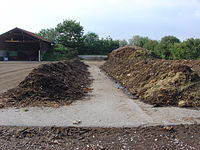
Photo from wikipedia
Five different inocula from cow manure, goat manure, pig manure, and rumen fluid (RU) and microbial sludge from anaerobic digestion were screened to select anaerobic lignocellulolytic microbial consortium (ALMC) of… Click to show full abstract
Five different inocula from cow manure, goat manure, pig manure, and rumen fluid (RU) and microbial sludge from anaerobic digestion were screened to select anaerobic lignocellulolytic microbial consortium (ALMC) of high efficacy in degradation of filter paper (FP), microcrystalline cellulose (MCC), and rice straw (RS) to produce methane. RU from Bubalus bubalis demonstrated the highest growth rate RU inoculum (10.45 mgVS/day); fastest degradation rate of FP, MCC, and RS (125.00, 50.07, and 25.43 mgVS/day); and highest methane production rate (6.23 ml/day). To obtain the enriched and stabilized ALMC from RU, consecutive batch subculturing was used and reached at 25 passages, namely, E25. The efficacies of E25 in RS removal and methane production were 78%VS and 293 ml/gVSadded compared with initial inoculum (E0) at 46% VS and 138 ml/gVSadded, respectively, within 14 days of incubation time. The efficacies of E25 in RS removal and methane production were 1.7- and 2.12-folds higher than of E0, respectively. E25 showed high ability to utilize various carbon sources (68%) from Biolog EcoPlate assay. It was confirmed that E25 could degrade derivatives of cellulose, hemicellulose, and lignin. Metagenomic analysis by 16 s and shotgun sequencing of E25 found dominant species of hydrolytic/fermentative bacteria (Proteiniphilum acetatigenes, Pyramidobacter piscolens, Syntrophus aciditrophicus, Mesotoga prima, and Candidatus Cloacimonas acidaminovorans) and methanogens (Methanoculleus bourgensis, Methanoculleus marisnigri, Methanofollis liminatans, Methanosarcina mazei, and Methanosaeta harundinacea). This stabilized E25 with enrichment of lignocellulolytic and fermentative bacteria as well as hydrogenotrophic and acetoclastic methanogens shows its efficacy in accelerating RS degradation and methane production.
Journal Title: Bioenergy Research
Year Published: 2020
Link to full text (if available)
Share on Social Media: Sign Up to like & get
recommendations!